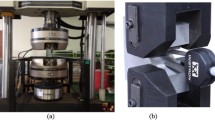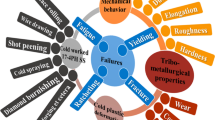Abstract
Hydrocarbons, water, carbon dioxide, hydrogen sulfide, chloride, high temperatures and pressures are all involved in the oil and gas production. Thus, corrosion, particularly sulfide stress cracking (SSC), poses a great threat to the integrity of well components such as tubing, casing, packer, and wellhead assembly. Sometimes, SSC can lead to catastrophic failures and must be addressed due to operational security and environmental concerns. Localized corrosion, including SSC can be reduced greatly with the appropriate material selection and optimization of critical operational parameters. The material selection is performed according to service environments vis-a-vis mechanical/ metallurgical attributes of the alloys as prescribed in standards such as API 5CT and ANSI/NACE MR0175/ISO 15156. Currently, corrosion-resistant alloys (CRAs) such as martensitic and duplex stainless steels, nickel, titanium and other precipitation hardened alloys are available and used in oil and gas industries because of their superior mechanical and corrosion properties. Owing to the operating environmental reasons, designer often opt for more expensive CRAs as compared to relatively less expensive materials which fall close to the performance boundary of materials selection criteria, thereby increasing overall cost of crude oil production. Thus, there is a paramount requirement to ascertain the candidate materials appropriately without bearing the cost penalties of over-specifications or the performance shortfalls of under-specified alloys when new fields are discovered. In this paper the application domains of 13Cr martensitic stainless steels are reviewed vis-a-vis limits prescribed in ANSI/NACE MR0175/ISO 15156 standard. The paper will aid in the selection of cost-effective materials for oil and gas production when temperature, pressure, hydrogen sulfide concentration, pH, and salinity vary in different directions and cannot be well defined within standard limits.








Similar content being viewed by others
References
Iannuzzi M, Chapter 15- Environmentally assisted cracking (EAC) in oil and gas production, Book: Stress Corrosion Cracking: Theory and Practice, Woodhead Publishing Series in Metals and Surface Engineering (2011), p 570.
Singer M, Brown B, and Camacho A, Nesic S Combined Effect of CO2, H2S and Acetic Acid on Bottom of the Line Corrosion, CORROSION 2007, Paper no. 07661, (Houston TX: NACE), (2007).
Kermani B, Materials optimization for oil and gas sour production. CORROSION 2000, Paper no. 00155, (Houston TX: NACE), (2000).
Kurahashi H, Sone Y, Wada K, and Nakai Y, Corrosion and Stress Corrosion Behavior of 13Cr Martensitic Stainless Steels in CO2-H2S-Cl- Environment, Kawasaki Steel Technical Report, No.14 (1986).
Rhodes P R, Corrosion 57 (2001) 923.
Turnbull A, and Griffiths A, Corros. Eng. Sci. Technol. 38 (2003) 21.
Kimura M, Mochizuki R, Yamazaki Y, Sakata K, and Tamari T, Development of New 15Cr stainless steel OCTG with superior corrosion resistance, CORROSION 2005, paper no: (Houston, TX: NACE), (2005).
Rebak R, Environmentally assisted cracking behavior of nickel alloys in oil and gas applications: a review, Euro Corr 2010, Paper 4737, (Moscow: European Federation of Corrosion), (2010).
Sridhar N, and Thodla R, Corros. Sci. Technol. 53 (2018) 75.
Cobmes J D, Kerr J G, and Klein L J, Pet Eng. Intl 55 (1983) 91.
Garrison WM, and Amuda MOH, Stainless Steels: Martensitic, In: Reference Module in Materials Science and Materials Engineering, Elsevier. https://doi.org/10.1016/b978-0-12-803581-8.02527-3
ANSI/NACE MR0175/ISO 15156—Petroleum and natural gas industries - Materials for use in H2S containing environments in oil and gas production, part (1–3): (Houston, TX: NACE International), (2015).
Tamaki A, A new 13Cr OCTG for High Temperature and High Chloride CO2 Environments, CORROSION 1989, paper no.469, (Houston, TX: NACE), (1989).
MUeda, Kushida T, Kondo K, and Kudo T, Corrosion Resistance of l3Cr-5Ni-2Mo Martensitic Stainless Steel, CORROSION 1992, paper no.55, (Houston, TX: NACE), (1992).
Asahi H, Hara T, Kawakami A, and Takahashi A, Development of Sour Resistant Modified 13Cr OCTG, CORROSION 1995, paper no.79, (Houston. TX: NACE), (1995).
Caldwell E Zhang H, and LGoodman, A Selection Methodology for 13Cr-Type Alloy Oil Country Tubular Goods, Society of Petroleum Engineers 2014, SPE-169633-MS, (Scotland: SPE International Oilfield Corrosion Conference and Exhibition), (2014).
Vitale DD, Effect of Hydrogen Sulfide Partial Pressure, pH and Chloride content on the SSC resistance of Martensitic SS and Precipitation Hardened Stainless Steel, CORROSION 1999, Paper no. 99584, (Houston TX: NACE), (1999).
Kimura M, Miyata Y, Yamane Y, Toyooka T, Nakano Y, and Murase F, CORROSION 55 (1999) 756.
Marchebois H, and Alami HE, Sour service limits of 13% Cr and super 13% Cr stainlesssteels for octg: effect of environmental factors, Corrosion 2009, Paper No.09084 (Houston, TX: NACE), (2009).
Craig B D, and Krauss G, Metall. Trans A A11 (1980) 1799.
Asahi H, and Hara T, Corrosion performance of modified 13CR OCTG, CORROSION 1996, Paper no. 061 (Houston, TX: NACE), (1996).
Kimura M, Miyata Y, Yamane Y, Toyooka T, and Nakano Y, Corrosion resistance of high strength modified 13Cr steel, CORROSION 1997, Paper no. 022 (Houston, TX: NACE), (1997).
Kappes M, Iannuzzi M, Rebak R B, and Carranza R M, Corros. Rev. 32 (2014) 101.
Takuya H, and Hitoshi A, ISIJ Int. 40 (2000) 1134.
Kimura M, Yiyata Y, Toyooka T, and Kitahaba Y, Effects of Retained Austenite on Corrosion Performance for Modified 13Cr Steel Pipe,” CORROSION 2000, Paper no. 00137 (Houston, TX: NACE), (2000).
Szklarz KE, and Claus DJ, Chloride Concentration, Applied Stress and the Use of CA6NM As Impellers in Sour Gas Compressors, CORROSION 2004, Paper no. 04133 (Houston, TX: NACE), (2004).
LScoppio, and Nice P, Application Limits for Martensitic Stainless Steel Forged Bar-Stock Alloy UNS S41500 (F6NM), Corrosion 2015, Paper No.5477 (Houston, TX: NACE), (2015).
Sakamoto S, Kawakami A, Asahi H, and Nakamura A, Effect of Environmental Factors and Yield Strength on Sulfide Stress Cracking Property of AISI 420 Stainless Steel, CORROSION 1995, Paper no. 95082 (Houston, TX: NACE), (1995).
Sakamoto S, Maruyama K, HAsahi, and Kaneta H, Effects of Environmental Factors on SSC Property ofModified 13Cr Steels in Oil and Gas Fields CORROSION 1997, Paper no. 97021, (Houston TX: NACE), (1997).
Chambers B, Kane R, and Yunovich M, Implications of Temperature and Buffering Systems for Laboratory Testing of Alloy Steel and 13Cr Materials in Oil and Gas Production Environments, CORROSION 2011, paper no. 11096 (Houston, TX: NACE), (2011).
Hashizume S, Inohara Y, and Masamura K, Effects of pH and PH2S on SSC Resistance of Martensitic Stainless Steels, Corrosion 2000, Paper No.00130 (Houston, TX: NACE), (2000).
Hashizume S, Masamura K, and Yamazaki K, Performance of High Strength Super 13%Cr Martensitic Stainless Steels, Corrosion 2003, Paper No.03095 (Houston, TX: NACE), (2003).
Takabe H, Ueda M, Martin JW, and Nice PI, Application Limits for 110ksi Strength Grade Super 13Cr steel in CO2 Environments Containing Small Amounts of H2S, Corrosion 2009, Paper No. 09083 (Houston, TX: NACE), (2009).
Kermani B, Cooling P, Martin JW, and Nice PI, The application limits of alloyed 13%Cr tubular steels for downhole duties, CORROSION ‘98, Paper No. 094, (Houston TX: NACE), (1998).
ANSI/NACE TM0177, Laboratory Testing of Metals for Resistance to Sulfide Stress Cracking and Stress Corrosion Cracking in H2S, (Houston, TX: NACE International).
Hara T, and Asahi H, Corrosion 56 (2000) 533.
Kumar A, Srivastava M, Shehhi AA, Daghar TA, Abdulhai W, and Gan CL, Fit-for-service qualification of existing 13Cr tubulars in mildly sour wells based on thermodynamic approach, Abu Dhabi International Petroleum Exhibition & Conference, Doc ID: SPE-192947-MS (2018).
EFC Publication 16, A working party report on guidelines on materials requirements for carbon and low alloy steels for H2S containing environments in oil and gas production, Maney publishing 2009, 3rd edition: (European Federation of Corrosion), (2009).
Klein LJ, I&S Cracking Resistance of Type 420 Stainless Steel Tubulars, CORROSION 1984, paper no. 211, (Houston, TX: NACE) (1984).
Galis MF, and Damman JJ, 13 Percent Chromium Steels for Slightly Sour Service, CORROSION 1991, paper no. 20, (Houston, TX: NACE), (1991).
Mori T, Okazawa T, Ueda M, and Kushidda T, Corrosion Performance of Super 13Cr Steel in CO2 Environments Containing a Small Amount of H2S, Corrosion Asia 1994, (Houston, TX: NACE), (1994).
Ueda M, Kushida T, and Mori T, Evaluation of SSC Resistance on Super 13Cr Stainless Steel in Sour Applications, CORROSION 1995, paper no. 80, (Houston, TX: NACE) (1995).
Miyata Y, Yamane Y, Furukimi O, Niwa H, and Tamaki K, Corrosion of New 13Cr Martensitic Stainless Steel OCTG in Severe CO2 Environment, CORROSION 1995, paper no. 83, (Houston, TX: NACE) (1995).
Craig BD, and Smith LM, Corrosion Resistant Alloys (CRAs)in the oil and gas industry– selection guidelines update, Nickel institute technical series no 10073, 2011, 3rd edition: (Nickel Institute), (2011).
NACE TM0198 Slow strain rate test method for screening corrosion-resistant alloys (cras) for stress corrosion cracking in sour oilfield service, (Houston, TX: NACE international)
EFC Publication 17, A working party report on guidelines on corrosion resistant alloys for oil and gas production: guidance on general requirements and test methods for h2s service, Maney publishing 2002, 2nd edition: (European Federation of Corrosion), (2002).
Author information
Authors and Affiliations
Corresponding authors
Additional information
Publisher's Note
Springer Nature remains neutral with regard to jurisdictional claims in published maps and institutional affiliations.
Rights and permissions
Springer Nature or its licensor (e.g. a society or other partner) holds exclusive rights to this article under a publishing agreement with the author(s) or other rightsholder(s); author self-archiving of the accepted manuscript version of this article is solely governed by the terms of such publishing agreement and applicable law.
About this article
Cite this article
Meena, L.K., Gorja, S.R., Bhardwaj, A. et al. Sour Service Domains of 13Cr Martensitic Stainless Steels: A Review of State-of-Art Knowledge vis-à-vis ANSI/NACE MR0175/ISO 15156. Trans Indian Inst Met 77, 1361–1371 (2024). https://doi.org/10.1007/s12666-023-03253-0
Received:
Accepted:
Published:
Issue Date:
DOI: https://doi.org/10.1007/s12666-023-03253-0




